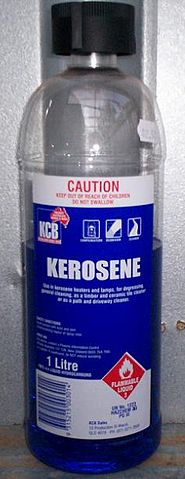Kerosene

Kerosene is a flammable liquid mixture of chemicals that are produced in the distillation of crude oil. To produce kerosene, crude oil is distilled in a distillation tower in a process similar to that used to produce diesel and gasoline.[2] It is a medium weight distillate in the refining process, and can be produced by distilling crude oil (here it is known as straight run kerosene) or by hydrocarbon cracking heavier petroleum (here it is known as cracked kerosene). The chemical composition of kerosene is fairly complex, and it is a complex mixture of paraffins (55.2%), naphthenes (40.9%), and aromatic hydrocarbons (3.9%). Kerosene tends to contain hydrocarbons that have anywhere from 11 to 13 carbons in the chains.[3] Liquid kerosene fuels contain potentially harmful compounds, including hexane and benzene.[4]
Uses
Kerosene is a major component of aviation fuel, making up more than 60% of the fuel. In addition, it can be used as an oil in central heating systems and can be used as a cleaning agent.[2]
Although the use of kerosene in many places has decreased over the years as a result of improved access to electricity and natural gas, it is still used extensively in the developing world for cooking, heating, and lighting.[2] Kerosene cooking is extensive in developing countries, especially among urban populations. Kerosene is often seen as a good alternative to solid fuels, biomass, and coal and thus kerosene lanterns are used in places where access to electricity is not available. It is estimated that globally 500 million households use fuels such as kerosene for lighting.[4]
For more information on the importance of access to non-solid fuels, click here.
Health Risks
The use of kerosene as an oil in heaters can be dangerous and because of that it is not used frequently. When operating, kerosene heaters can cause degradation of air quality inside a home while producing toxic and carcinogenic gases. Because of this, kerosene is not actively used in home heating in most developed countries.[5]
In developing countries, the widespread use of kerosene comes with numerous different issues. Hazards of kerosene use include poisoning, fires, and explosions. As well, some kerosene lamps emit fine particulates, carbon monoxide, nitric oxides (NOx), and sulfur dioxide when burned. These by-products may reduce lung function and increase risks of asthma and cancer.[4] Taking into account the risks of using kerosene, cleaner alternatives to kerosene technologies for lighting and cooking should be investigated - although kerosene is still a safer option in many cases than using solid fuels.
Climate Issues
Generally speaking, kerosene lamps are inefficient and produce harmful by-products of combustion when used. When kerosene is burned in wick lamps, about 7-9% of the kerosene consumed is converted to particulate matter that is almost entirely black carbon - a harmful emission. When wood is burned, less than half a percent is turned to black carbon. Reduction of black carbon emissions is marked as a potential way to reduce climate warming, and since kerosene lamps are such a major sources of black carbon, limiting their use could be beneficial to the environment. Alternatives to this kerosene use involve more electrification or using cheap LED lamps.[6]
References
- ↑ Wikimedia Commons. (May 20, 2015). Kerosene Bottle [Online]. Available: http://en.wikipedia.org/wiki/Kerosene#/media/File:Kerosene_bottle.jpg
- ↑ 2.0 2.1 2.2 Health Protection Agency. (May 20, 2015). Compendium of Chemical Hazards: Kerosene (Fuel Oil). [Online]. Available: http://www.who.int/ipcs/emergencies/kerosene.pdf
- ↑ Stephen Marshak. (May 21, 2015). Earth: Portrait of a Planet, 3rd ed. New York, NY, U.S.A:W.W. Norton & Company, 2008
- ↑ 4.0 4.1 4.2 M.Bates, A.Gauthier, N. Lam, K.Smith. (May 21, 2015). Kerosene: A Review of Household Uses and their Hazards in Low- and Middle-Income Countries [Online]. Available: http://www.ncbi.nlm.nih.gov/pmc/articles/PMC3664014/
- ↑ Gordon Aubrecht. (May 21, 2015). Energy: Physical, Environmental, and Social Impact, 3rd ed. San Francisco, CA, U.S.A.: Pearson, 2006.
- ↑ Jeffrey Stumpf. (May 25, 2015). Climate impacts of kerosene lamps used in developing countries [Online]. Available: http://www.niehs.nih.gov/news/newsletter/2013/1/science-kerosene/

